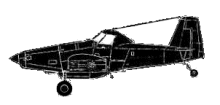
ASN Wikibase Occurrence # 67934
This information is added by users of ASN. Neither ASN nor the Flight Safety Foundation are responsible for the completeness or correctness of this information.
If you feel this information is incomplete or incorrect, you can submit corrected information.
| Date: | Saturday 15 August 2009 |
| Time: | 11:16 |
| Type: |  Air Tractor AT-802A |
| Owner/operator: | Rustys Flying Service |
| Registration: | N802LL |
| MSN: | 802A-0023 |
| Year of manufacture: | 1995 |
| Total airframe hrs: | 3118 hours |
| Engine model: | P&W Canada PT6A-65R |
| Fatalities: | Fatalities: 1 / Occupants: 1 |
| Aircraft damage: | Destroyed |
| Category: | Accident |
| Location: | Near Corning, Iowa -
 United States of America United States of America
|
| Phase: | En route |
| Nature: | Ferry/positioning |
| Departure airport: | Rantoul, IL (TIP) |
| O'Neill, NE (ONL) | |
| Investigating agency: | NTSB |
| Confidence Rating: |
The flight was established in an extended climb on a west-northwest course toward the intended destination as it approached a line of thunderstorms. Radar data depicted the airplane passing through 12,000 feet mean sea level (msl) and continuing to 16,000 feet msl over a 9-minute period. After reaching 16,000 feet, the flight altered course several times, apparently in an attempt to clear the line of thunderstorms. The maximum altitude return was 17,700 feet msl during the flight. About 1-1/2 minutes before the accident, the flight reversed to an easterly course and descended from 17,400 feet msl to 15,200 feet msl. The airplane momentarily climbed to 16,300 feet msl during that time. About 50 seconds prior to the accident, the airplane entered a descent from 13,400 feet msl on a steady southeast course. The descent continued until impact. The airplane impacted an open field. It was fragmented during the impact sequence. Sections of all flight control surfaces were observed at the accident site. No malfunctions consistent with a preimpact failure were observed during the postaccident examination. The radar data indicated that the pilot operated the unpressurized airplane above 12,000 feet msl for approximately 24 minutes, and above 15,000 feet msl for at least 14 minutes of that time. Federal Aviation Administration publications note that at cabin altitudes between 12,000 and 15,000 feet "judgment, memory, alertness, coordination and ability to make calculations are impaired." They also stated that "pilot performance can seriously deteriorate within 15 minutes at 15,000 feet."
Probable Cause: The in-flight loss of control due to the pilot's impairment as a result of hypoxia. Contributing to the accident was the pilot's decision to operate the unpressurized airplane at an altitude requiring supplemental oxygen without having any oxygen available.
Accident investigation:
 |
|
Sources:
NTSB
Location
Revision history:
| Date/time | Contributor | Updates |
|---|---|---|
| 17-Aug-2009 20:45 | slowkid | Added |
| 17-Aug-2009 20:46 | slowkid | Updated |
| 17-Aug-2009 20:57 | RobertMB | Updated |
| 03-Dec-2017 13:47 | ASN Update Bot | Updated [Time, Operator, Other fatalities, Nature, Departure airport, Destination airport, Source, Narrative] |
Corrections or additions? ... Edit this accident description
The Aviation Safety Network is an exclusive service provided by:


 ©2024 Flight Safety Foundation
©2024 Flight Safety Foundation